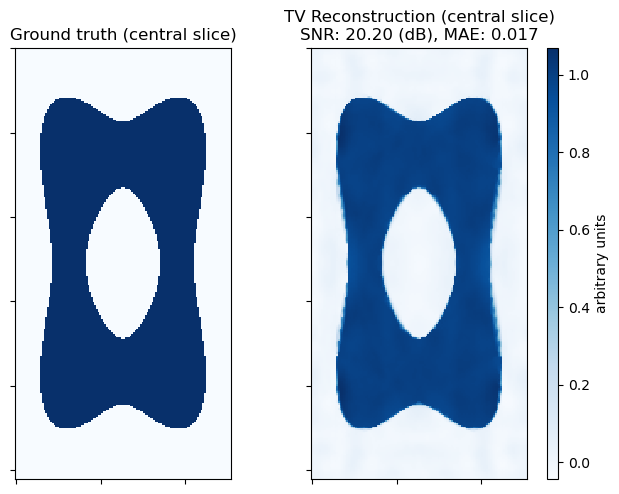3D TV-Regularized Sparse-View CT Reconstruction (ADMM Solver)¶
This example demonstrates solution of a sparse-view, 3D CT reconstruction problem with isotropic total variation (TV) regularization
\[\mathrm{argmin}_{\mathbf{x}} \; (1/2) \| \mathbf{y} - C \mathbf{x}
\|_2^2 + \lambda \| D \mathbf{x} \|_{2,1} \;,\]
where \(C\) is the X-ray transform (the CT forward projection operator), \(\mathbf{y}\) is the sinogram, \(D\) is a 3D finite difference operator, and \(\mathbf{x}\) is the desired image.
In this example the problem is solved via ADMM, while proximal ADMM is used in a companion example.
[1]:
import numpy as np
from mpl_toolkits.axes_grid1 import make_axes_locatable
import scico.numpy as snp
from scico import functional, linop, loss, metric, plot
from scico.examples import create_tangle_phantom
from scico.linop.xray.astra import XRayTransform3D
from scico.optimize.admm import ADMM, LinearSubproblemSolver
from scico.util import device_info
plot.config_notebook_plotting()
Create a ground truth image and projector.
[2]:
Nx = 128
Ny = 256
Nz = 64
tangle = snp.array(create_tangle_phantom(Nx, Ny, Nz))
n_projection = 10 # number of projections
angles = np.linspace(0, np.pi, n_projection) # evenly spaced projection angles
C = XRayTransform3D(
tangle.shape, det_count=[Nz, max(Nx, Ny)], det_spacing=[1.0, 1.0], angles=angles
) # CT projection operator
y = C @ tangle # sinogram
Set up problem and solver.
[3]:
λ = 2e0 # ℓ2,1 norm regularization parameter
ρ = 5e0 # ADMM penalty parameter
maxiter = 25 # number of ADMM iterations
cg_tol = 1e-4 # CG relative tolerance
cg_maxiter = 25 # maximum CG iterations per ADMM iteration
# The append=0 option makes the results of horizontal and vertical
# finite differences the same shape, which is required for the L21Norm,
# which is used so that g(Ax) corresponds to isotropic TV.
D = linop.FiniteDifference(input_shape=tangle.shape, append=0)
g = λ * functional.L21Norm()
f = loss.SquaredL2Loss(y=y, A=C)
solver = ADMM(
f=f,
g_list=[g],
C_list=[D],
rho_list=[ρ],
x0=C.T(y),
maxiter=maxiter,
subproblem_solver=LinearSubproblemSolver(cg_kwargs={"tol": cg_tol, "maxiter": cg_maxiter}),
itstat_options={"display": True, "period": 5},
)
Run the solver.
[4]:
print(f"Solving on {device_info()}\n")
tangle_recon = solver.solve()
hist = solver.itstat_object.history(transpose=True)
print(
"TV Restruction\nSNR: %.2f (dB), MAE: %.3f"
% (metric.snr(tangle, tangle_recon), metric.mae(tangle, tangle_recon))
)
Solving on GPU (NVIDIA GeForce RTX 2080 Ti)
Iter Time Objective Prml Rsdl Dual Rsdl CG It CG Res
-----------------------------------------------------------------
0 9.58e+00 1.559e+08 1.098e+03 4.701e+05 25 3.991e-03
5 4.10e+01 1.861e+05 1.294e+02 5.987e+02 25 1.953e-04
10 6.95e+01 1.657e+05 4.562e+01 1.051e+02 15 9.501e-05
15 8.87e+01 1.641e+05 3.663e+01 5.943e+01 19 9.021e-05
20 1.04e+02 1.632e+05 2.240e+01 3.614e+01 7 9.072e-05
24 1.10e+02 1.631e+05 1.290e+01 8.143e+00 3 8.961e-05
TV Restruction
SNR: 20.20 (dB), MAE: 0.017
Show the recovered image.
[5]:
fig, ax = plot.subplots(nrows=1, ncols=2, figsize=(7, 6))
plot.imview(
tangle[32],
title="Ground truth (central slice)",
cmap=plot.cm.Blues,
cbar=None,
fig=fig,
ax=ax[0],
)
plot.imview(
tangle_recon[32],
title="TV Reconstruction (central slice)\nSNR: %.2f (dB), MAE: %.3f"
% (metric.snr(tangle, tangle_recon), metric.mae(tangle, tangle_recon)),
cmap=plot.cm.Blues,
fig=fig,
ax=ax[1],
)
divider = make_axes_locatable(ax[1])
cax = divider.append_axes("right", size="5%", pad=0.2)
fig.colorbar(ax[1].get_images()[0], cax=cax, label="arbitrary units")
fig.show()
